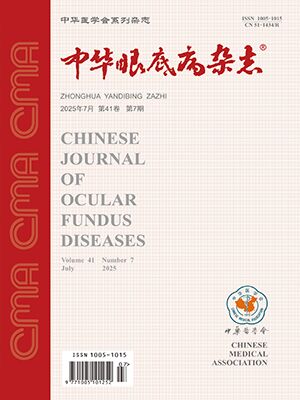| 1. |
Terashima H, Hasebe H, Okamoto F, et al. Combination therapy of intravitreal ranibizumab and subthreshold micropulse photocoagulation for macular edema secondary to branch retinal vein occlusion: 6-month result[J]. Retina, 2019, 39(7): 1377-1384. DOI: 10.1097/IAE.0000000000002165.
|
| 2. |
雍红芳, 戚卉, 吴瑛洁, 等. 视网膜静脉阻塞继发黄斑水肿发病机制及黄斑水肿影响视功能的研究进展[J]. 国际眼科杂志, 2019, 19(11): 1888-1891. DOI: 10.3980/j.issn.1672-5123.2019.11.17.Yong HF, Qi H, Wu YJ, et al. Research progress on the pathogenesis of macular edema secondary to retinal vein occlusion and the effect of macular edema on visual function[J]. Int Eye Sci, 2019, 19(11): 1888-1891. DOI: 10.3980/j.issn.1672-5123.2019.11.17.
|
| 3. |
Li Q, Guo Z, Liu F, et al. The effects of altitude-related hypoxia exposure on the multiscale dynamics of blood pressure fluctuation during sleep: the observation from a pilot study[J]. Nat Sci Sleep, 2021, 13: 1147-1155. DOI: 10.2147/NSS.S319031.
|
| 4. |
Billioti de Gage S, Bertrand M, Grimaldi S, et al. Risk of myocardial infarction, stroke, or death in new users of intravitreal aflibercept versus ranibizumab: a nationwide cohort study[J]. Ophthalmol Ther, 2022, 11(2): 587-602. DOI: 10.1007/s40123-021-00451-1.
|
| 5. |
Sivaprasad S, Amoaku WM, Hykin P, et al. The Royal College of Ophthalmologists Guidelines on retinal vein occlusions: executive summary[J]. Eye (Lond), 2016, 30(4): 642. DOI: 10.1038/eye.2016.16.
|
| 6. |
Gale R, Pikoula M, Lee AY, et al. Real world evidence on 5661 patients treated for macular oedema secondary to branch retinal vein occlusion with intravitreal anti-vascular endothelial growth factor, intravitreal dexamethasone or macular laser[J]. Br J Ophthalmol, 2021, 105(4): 549-554. DOI: 10.1136/bjophthalmol-2020-315836.
|
| 7. |
朱成义, 潘兰兰, 伊琼, 等. 玻璃体腔注射雷珠单抗治疗对视网膜分支静脉阻塞继发黄斑水肿患者房水中细胞因子表达水平的影响[J]. 中华眼底病杂志, 2020, 38(9): 739-743. DOI: 10.3760/cma.j.cn511434-20211122-00650.Zhu CY, Pan LL, Yi Q, et al. The effect of intravitreal ranibizumab on the expression of cytokines in aqueous humor of patients with macular edema due to branch retinal vein occlusion[J]. Chin J Ocul Fundus Dis, 2020, 38(9): 739-743. DOI: 10.3760/cma.j.cn511434-20211122-00650.
|
| 8. |
Baker J, Safarzadeh MA, Incognito AV, et al. Functional optical coherence tomography at altitude: retinal microvascular perfusion and retinal thickness at 3, 800 meters[J]. J Appl Physiol (1985), 2022, 133(3): 534-545. DOI: 10.1152/japplphysiol.00132.2022.
|
| 9. |
Inagaki M, Hirano Y, Yasuda Y, et al. Twenty-four month results of intravitreal ranibizumab for macular edema after branch retinal vein occlusion: visual outcomes and resolution of macular edema[J]. Semin Ophthalmol, 2021, 36(7): 482-489. DOI: 10.1080/08820538.2021.1890147.
|
| 10. |
邓昕熠, 刘辉, 毛剑波, 等. 基于深度学习的双模态眼底照相机视网膜分支静脉阻塞的血氧饱和度及血管形态学研究[J]. 中华眼底病杂志, 2022, 38(2): 108-113. DOI: 10.3760/cma.j.cn511434-20220104-00010.Deng XY, Liu H, Mao JB, et al. The oxygen saturation and vascular morphology of branch retinal vein occlusion by a dual-model fundus camera based on deep learning[J]. Chin J Ocul Fundus Dis, 2022, 38(2): 108-113. DOI: 10.3760/cma.j.cn511434-20220104-00010.
|
| 11. |
Ryu G, Park D, Lim J, et al. Macular microvascular changes and their correlation with peripheral nonperfusion in branch retinal vein occlusion[J]. Am J Ophthalmol, 2021, 225: 57-68. DOI: 10.1016/j.ajo.2020.12.026.
|
| 12. |
Suzuki N, Hirano Y, Tomiyasu T, et al. Collateral vessels on optical coherence tomography angiography in eyes with branch retinal vein occlusion[J]. Br J Ophthalmol, 2019, 103(10): 1373-1379. DOI: 10.1136/bjophthalmol-2018-313322.
|
| 13. |
Brar M, Sharma M, Grewal S, et al. Quantification of retinal microvasculature and neurodegeneration changes in branch retinal vein occlusion after resolution of cystoid macular edema on optical coherence tomography angiography[J]. Indian J Ophthalmol, 2019, 67(11): 1864-1869. DOI: 10.4103/ijo.IJO_1554_18.
|
| 14. |
Segal O, Yavnieli R, Mimouni M, et al. Optical coherence tomography biomarkers predicting visual acuity change after intravitreal bevacizumab injections for macular edema secondary to branch retinal vein occlusion[J]. Ophthalmologica, 2022, 245(1): 19-24. DOI: 10.1159/000519373.
|
| 15. |
Kim JT, Chun YS, Lee JK, et al. Comparison of vessel density reduction in the deep and superficial capillary plexuses in branch retinal vein occlusion[J]. Ophthalmologica, 2020, 243(1): 66-74. DOI: 10.1159/000502385.
|
| 16. |
Algahtani FH, AlQahtany FS, Al-Shehri A, et al. Features and incidence of thromboembolic disease: a comparative study between high and low altitude dwellers in Saudi Arabia[J]. Saudi J Biol Sci, 2020, 27(6): 1632-1636. DOI: 10.1016/j.sjbs.2020.03.004.
|




